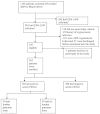Prevalence and factors associated with cryptococcal antigenemia among severely immunosuppressed HIV-infected adults in Uganda: a cross-sectional study
- PMID: 22417404
- PMCID: PMC3334679
- DOI: 10.1186/1758-2652-15-15
Prevalence and factors associated with cryptococcal antigenemia among severely immunosuppressed HIV-infected adults in Uganda: a cross-sectional study
Abstract
Background: Cryptococcal infection is a common opportunistic infection among severely immunosuppressed HIV patients and is associated with high mortality. Positive cryptococcal antigenemia is an independent predictor of cryptococcal meningitis and death in patients with severe immunosuppression. We evaluated the prevalence and factors associated with cryptococcal antigenemia among patients with CD4 counts of 100 cells/mm(3) or less in Mulago Hospital, Kampala, Uganda. Screening of a targeted group of HIV patients may enable early detection of cryptococcal infection and intervention before initiating antiretroviral therapy. Factors associated with cryptococcal antigenemia may be used subsequently in resource-limited settings in screening for cryptococcal infection, and this data may also inform policy for HIV care.
Methods: In this cross-sectional study, HIV-infected patients aged 18 years and older with CD4 counts of up to 100 cells/mm(3) were enrolled between December 2009 and March 2010. Data on socio-demographics, physical examinations and laboratory tests were collected. Factors associated with cryptococcal antigenemia were analyzed using multiple logistic regression.
Results: We enrolled 367 participants and the median CD4 count was 23 (IQR 9-51) cells/mm(3). Sixty-nine (19%) of the 367 participants had cryptococcal antigenemia. Twenty-four patients (6.5%) had cryptococcal meningitis on cerebrospinal fluid analysis and three had isolated cryptococcal antigenemia. Factors associated with cryptococcal antigenemia included: low body mass index of 15.4 kg/m2 or less (adjusted odds ratio, AOR = 0.5; 95% CI 0.3-1.0), a CD4(+) T cell count of less than 50 cells/mm(3) (AOR = 2.7; 95% CI1.2-6.1), neck pain (AOR = 2.3; 95% CI 1.2-4.6), recent diagnosis of HIV infection (AOR = 1.9; 95% CI 1.1-3.6), and meningeal signs (AOR = 7.9; 95% CI 2.9-22.1). However, at sub-analysis of asymptomatic patients, absence of neck pain (AOR = 0.5), photophobia (AOR = 0.5) and meningeal signs (AOR = 0.1) were protective against cryptococcal infection.
Conclusions: Cryptococcal antigenemia is common among severely immunosuppressed HIV patients in Mulago Hospital, Kampala, Uganda. Independent predictors of positive serum cryptococcal antigenemia were CD4(+) T cell counts of less than 50 cells/mm, low body mass index, neck pain, signs of meningeal irritation, and a recent diagnosis of HIV infection. Routine screening of this category of patients may detect cryptococcosis, and hence provide an opportunity for early intervention. Absence of neck pain, photophobia and meningeal signs were protective against cryptococcal infection compared with symptomatic patients.
Figures
Comment in
-
Response to comment on "prevalence and factors associated with cryptococcal antigenemia among severely immunosuppressed HIV-infected adults in Uganda (Oyella et al. 2012)".J Int AIDS Soc. 2012;15(2):18003. doi: 10.7448/ias.15.2.18003. J Int AIDS Soc. 2012. PMID: 22905363 Free PMC article. No abstract available.
-
Comment on "cryptococcal antigenemia among severely immunosuppressed HIV-infected adults in Uganda (Oyella et al. 2012)".J Int AIDS Soc. 2012;15(2):17977. doi: 10.7448/ias.15.2.17977. J Int AIDS Soc. 2012. PMID: 22905364 Free PMC article. No abstract available.
References
-
- Mirza SA, Phelan M, Rimland D, Graviss E, Hamil R, Brandt ME, Gardener T, Sattah M, de Leon GP, Baughman W, Hajjeh RA. The changing epidemiology of cryptococcosis: an update from population-based active surveillance in 2 large metropolitan areas, 1992- 2000. Clin Infect Dis. 2003;15(6):789–794. doi: 10.1086/368091. - DOI - PubMed
-
- Castelnuovo B, Manabe YC, Kiragga A, Kamya M, Easterbrook P, Kambugu A. Cause-specific mortality and the contribution of immune reconstitution inflammatory syndrome in the first 3 years after antiretroviral therapy initiation in an urban African cohort. Clin Infect Dis. 2009;15(6):965–972. doi: 10.1086/605500. - DOI - PubMed
-
- Kambugu A, Meya DB, Rhein J, O'Brien M, Janoff EN, Ronald AR, Kamya MR, Mayanja-Kizza H, Sande MA, Bohjanen DR. Outcomes of cryptococcal meningitis in Uganda before and after the availability of highly active antiretroviral therapy. Clin Infect Dis. 2008;15(11):1694–1701. doi: 10.1086/587667. - DOI - PMC - PubMed
Publication types
MeSH terms
Grants and funding
LinkOut - more resources
Full Text Sources
Medical
Research Materials



